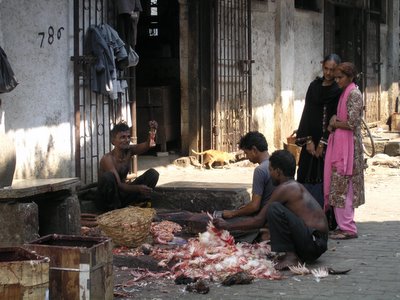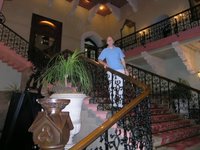(I have reached my maximum upload for photos on blogspot, so I have now replace them links to photos, imbedded in the text. Just click on the underlined link and it will take you to the photos which are saved in FlickR. To see all the FlickR photos taken by a number of people in our group, go to
http://www.flickr.com/photos/tags/Oct2005PE/)
We went to sleep to the sound of a Muslim prayer call blaring over a loud speaker, then woke in the morning to the same thing at 5 am. There are a lot more Muslims in this part of India. I actually think the prayer call sounds kind of cool, but when you're not used to it, it is a little hard to sleep to. There were also a lot of roosters crowing and train whistles blowing early in the day. And of course the ever present sound of horns honking in the traffic. (That would explain why the hotel supplied us with a set of earplugs on the night table.) Once we were awake, we started the day with a wonderful buffet breakfast. There are so many cool Indian foods to try, it's really hard not to overeat. I wish I could remember the names of everything!
Breakfast was followed by a presentation given to our group by Vikram Akula, the CEO of SKS, which is the microfinance institution whose operations we were there to observe. He told us all about how he came to start SKS and a little about how it operates. You can find out more about SKS and the work that they do in India by visiting
http://www.sksindia.com/ (I could try and explain about SKS and microfinance but I think the website does a much better job).
Vikram is an amazing person, as were many of the people we met who work for SKS and Unitus. He was educated in the US, but felt a real need to return to India to use his education and influence to help alleviate poverty there. He is completely dedicated to SKS and we really enjoyed getting to know him. He was a real inspiration.
Unitus (the organization that sponsored our trip) works in partnership with microfinance institutions (MFIs) like SKS to help expand the number of people that they are able to reach. To watch a short video that describes the work that Unitus does in partnership with microfinance organizations such as SKS, visit
http://www.unitus.com/resource_mediaresources.asp#videos (the video explains it much better than I could, and has clips of some of the people that were with us on our trip)
In the afternoon, the large group
http://www.flickr.com/photos/24435927@N00/64089123/in/photostream/ was divided into three smaller groups that visited three different villages served by the Bhongir Branch (Nalgonda District) of SKS. It took about 1.5 hours to travel to our village, along a two-lane bumpy highway. The village we visited was just off the this road. We were there to attend a Compulsory Group Training meeting, where 5 new borrowers were admitted to the program, as well as a Group Recognition test, to ensure that the borrower group understands how the program works and what is expected of them. This was quite a moving experience.
The first thing we did was meet the five women who were being initiated, then took a tour of the village to see the homes where these women live. The SKS loan officer is required to do a quick survey of the property and to rate it, using a point system, based on the size and age of the home, as well as whether it had electricy and access to water, etc. The total number of points has to be below a certain number before the woman can qualify for a loan. We followed him around as he rated the homes of each of the 5 women.
Photos of borrowers in their homes:
http://www.flickr.com/photos/24435927@N00/64089120/in/photostream/http://www.flickr.com/photos/24435927@N00/64089119/in/photostream/It was a wonderful experience to see the home where these women live. We were impressed with how clean they were, even though they were very simple. The whole village seemed much cleaner than some of the other areas we had seen. The women were a bit shy, but still let us take some pictures. One of the girls was just 19 years old and had a 9 month old baby.
After touring their homes, we went into the little yard outside the home of one of the borrowers and watched the loan officer explain about interest. It was fascinating to watch, as the women are all illiterate and he had to use stones. He also taught them the borrower's pledge, which goes like this:
"We shall attend the weekly meetings without fail.
We shall pay back the loan installments without fail to our Sangam.
We shall help the needy in our Sangam, whenever required.
All the Sangam members will abide by the rules and responsibilities of the Sangam.
We shall use the loan amounts taken from the Sangam for uplifting our family economy."
For those of you wondering what a Sangam is, here is an excerpt from the SKS website that explains it.
"As groups are formed within a village, a collective or Sangam evolves which consists of a maximum of eight groups or 40 members. Sangam meetings are held on a weekly basis during which SKS staff collect and record group savings, loan distributions, and loan repayments. In addition, weekly sangam meetings serve as a forum for discussion of loan proposals, loan utilization, and community issues. Each Sangam elects a leader and deputy leader who are responsible for facilitating meetings and ensuring proper compliance with SKS procedures."
Everyone in the village was very interested in seeing who we were. Some gathered around us and others stared from a distance. We quickly made friends with the children when we brought out bubbles and stickers. The kids really liked it when we took pictures of them with our digital cameras, and then showed them what they looked like. We would usually start by taking a picture of one or two kids. Then a couple more would come and want their picture taken. Then a few more, until we had a whole crowd. The adults liked it when we took their pictures too.
There was one young woman who stood out to me. See
http://www.flickr.com/photos/24435927@N00/64089124/in/photostream/ (she is the one in the green). She spoke a little bit of English, and so we were able to communicate a bit. She had the most beautiful smile, and had a certain glow about her. She asked me who my husband was, and then said, "family". I had some photos of my family that I brought out to show her and told her that this was my family. I told her I have 4 daughters and 1 son. I showed her my daughter's wedding picture, and she pointed to Jeff and said "husband." I said, "yes." She smiled and told some of the other women to come and look. Pretty soon I had a whole group of women standing around me to look at my photos. They all smiled, and at that moment I felt a real bond of sisterhood because family was something we could all relate to.
When I looked out at these beautiful women and children, I couldn't help thinking about in the caste system how they are classified as "untouchables". How sad! They were beautiful and bright to me. It was a very moving experience when they all gathered outside our bus to wave goodbye.
To see photos of our visit to the village, you can click on the following links:
http://www.flickr.com/photos/unitus/61915042/http://www.flickr.com/photos/unitus/61915236/http://www.flickr.com/photos/24435927@N00/64089122/http://www.flickr.com/photos/24435927@N00/64089121/When we arrived back at the hotel in the evening, we were greeted by a lot of security guards and one of those metal detector things that we had to walk through before we were allowed to get on the elevator. This was because the Prime Minister of Mauritius was staying in our hotel. He was in Hyderabad to meet the governor and to visit with representatives of Bharat Electronics Limited, followed by a visit to Hitec City. I guess it was a pretty big deal because the newspaper said that the Hyderabad Police announced restrictions on traffic movements on some routes in the city in connection with his visit. Unfortunately, we saw all the hoopla, but didn't actually see the Prime Minister.
We did however have a surprise later in the evening. As we were standing outside of the banquet room waiting for the hotel staff to get our dinner ready, a beautiful young couple in traditional Indian clothing, followed by a large group of phototgraphers, walked by. We wondered what was going on, until we read the bulletin board that tells what is going on in all the banquet rooms. It turns out that there was a press meeting for the new Bollywood blockbuster, Taj Mahal, An Eternal Love story
http://www.panjabicity.co.uk/news/?c=59&a=1218, in the room next door to ours. So we had fun watching the papparazzi and observing the two stars. When we walked out of the banquet room after dinner, the crowds had dissipated somewhat, and the reporters were interviewing the producer/director of the film. A young man approached us and started chitchatting, asking us who we were and where we were from. Then he told us that he was working on the movie (I can't remember what he did exactly). We walked along slowly together, chatting away, when all of a sudden he looked over to a beautiful young woman sitting on a bench alone, and introduced her to us as the main actress in the movie. Her name is Sonya Jehan
http://www.telegraphindia.com/1050409/asp/calcutta/story_4594850.asp , and she told us that her mother is French and her father Pakistani. She aked us about ourselves, then told us that this was her first movie, and that she wasn't sure if she would do another one because she is a private person and was not enjoying all the publicity, and that she loves acting. She also told us that in real life she is married, but is not supposed to tell that to everyone. She is an extremely attractive girl, and it was a real thrill to have met her. I hope that we will be able to see the movie some day. Here's a link to an article that we cut out of the newspaper, telling all about her and the movie
http://www.hindu.com/fr/2005/10/28/stories/2005102802240100.htm

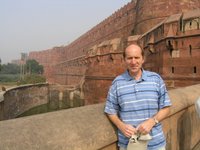
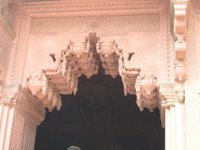

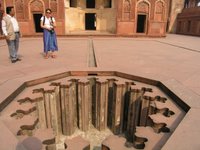
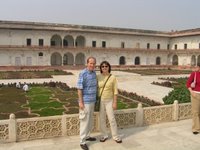

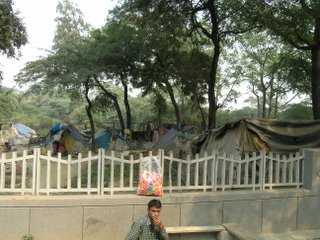
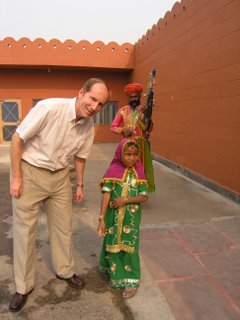
 In the evening, we had a wonderful dinner with the members of our group who were left. I think there were about 10 of us. The best part was that when we opened the menus, they had something besides Indian food. Not that we didn't like the Indian food, but it is a little hard on the stomach when you have it for every meal and are not used to all the spices. We had a fun time and some great conversation.
In the evening, we had a wonderful dinner with the members of our group who were left. I think there were about 10 of us. The best part was that when we opened the menus, they had something besides Indian food. Not that we didn't like the Indian food, but it is a little hard on the stomach when you have it for every meal and are not used to all the spices. We had a fun time and some great conversation.





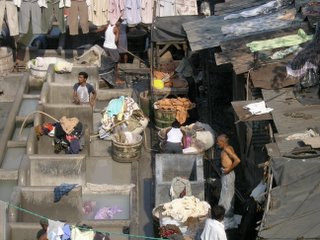
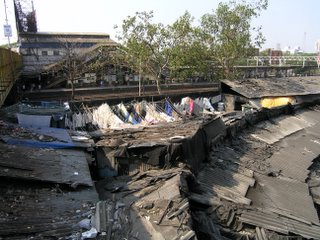

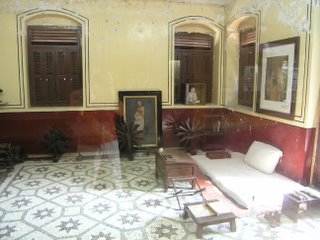


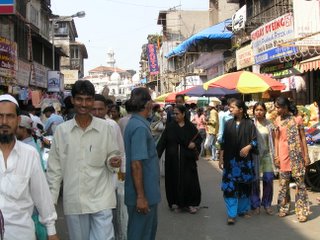




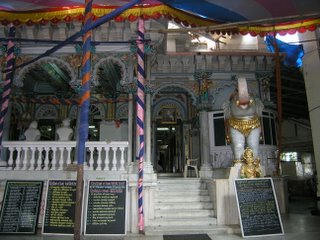





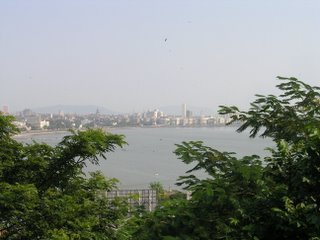


 This dirty little barefoot boy followed us all around the market. I wondered how he could stay healthy with so many germs around him. Perhaps he has developed an immunity to them from the constant exposure.
This dirty little barefoot boy followed us all around the market. I wondered how he could stay healthy with so many germs around him. Perhaps he has developed an immunity to them from the constant exposure.
